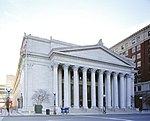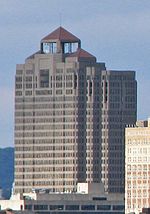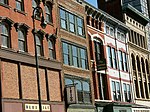Chapel Square Mall
1967 establishments in Connecticut2002 disestablishments in ConnecticutBuildings and structures in New Haven, ConnecticutDefunct shopping malls in the United StatesEconomy of New Haven, Connecticut ... and 3 more
Shopping malls disestablished in 2002Shopping malls established in 1967Shopping malls in Connecticut
The Chapel Square Mall was a shopping mall in downtown New Haven, Connecticut. It was one of the first fully enclosed air-conditioned downtown malls in the United States; it has now been converted into apartments.
Excerpt from the Wikipedia article Chapel Square Mall (License: CC BY-SA 3.0, Authors).Chapel Square Mall
New Haven
Geographical coordinates (GPS) Address Nearby Places Show on map
Geographical coordinates (GPS)
| Latitude | Longitude |
|---|---|
| N 41.3064 ° | E -72.9257 ° |
Address
New Haven
Connecticut, United States
Open on Google Maps







